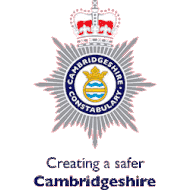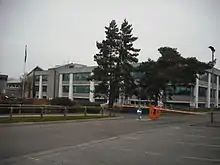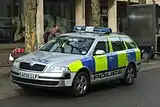Cambridgeshire Constabulary
Cambridgeshire Constabulary is the local territorial police force that covers the territory of the counties of Cambridgeshire and Peterborough. It provides law enforcement and security for an area of just under 3400 km² and population of nearly a million people in a predominantly rural county. The force of Cambridgeshire includes the cities of Cambridge, Ely and Peterborough, the market towns of St Ives, Huntingdon and St Neots, and the historic Fenland towns of Ramsey, Chatteris, Wisbech, Whittlesey and March. The constabulary's logo is a crowned Brunswick star with two wavy blue lines representing the two major rivers that flow the area, the Cam and the Nene.
| Cambridgeshire Constabulary | |
|---|---|
 | |
| Motto | Creating a safer Cambridgeshire |
| Agency overview | |
| Formed | 1836, 1965 (merger) |
| Preceding agencies |
|
| Volunteers | 84 |
| Annual budget | £134 million (2018) |
| Jurisdictional structure | |
| Operations jurisdiction | Cambridgeshire, England |
.svg.png.webp) | |
| Map of police area | |
| Size | 3,389 km2 (1,309 sq mi) |
| Population | 0.8 million |
| Legal jurisdiction | England & Wales |
| Constituting instrument | |
| General nature | |
| Operational structure | |
| Headquarters | Hinchingbrooke, Huntingdon |
| Police officers | 1,383[1] |
| PCSOs | 115 |
| Police and Crime Commissioner responsible |
|
| Agency executive |
|
| Area Commands | North (Peterborough, Fenland) South (Huntingdonshire, Cambridge, South Cambridgeshire, East Cambridgeshire) |
| Facilities | |
| Stations | 12
|
| Website | |
| cambs | |

According to a government report in July 2018 on policing numbers.[3] The force consists of 1,383 police officers (giving the county a ratio of 163 officers per 100,000 people), 111 police community support officers and 778 members of staff. Together with 229 special constables and 84 police support volunteers. It has a budget in for the year of 2018 of £134 million,[4] of which 78.4 million (58.5%) comes directly as an annual grant from the Home Office and the rest from local council taxes.
The head of the whole constabulary is Chief Constable Nick Dean, a former assistant chief constable of Norfolk Constabulary who came into the role as chief constable in October 2018. His deputies are head of investigations Deputy Chief Constable Jane Gyford, formerly a commander of the City of London Police and head of operations Assistant Chief Constable Vicki Evans, previously the Assistant Chief Constable of Dyfed-Powys Police.[5] One notable former chief constable is the current Lord Lieutenant of Cambridgeshire, Julie Spence who was chief constable from 2005 to 2010.
The force was overseen by the Police & Crime Commissioner who was Jason Ablewhite,[6] a former Conservative councillor of Huntingdonshire. He was supported by Deputy Police & Crime Commissioner Ray Bisby,[7] a former officer for the Royal Ulster Constabulary (now known as the Police Service of Northern Ireland). The commissioner's office is based at force headquarters in Huntingdon.[8] Jason Ablewhite resigned as the PCC in on 11 November 2019, due to a referral that was made to the Independent Office for Police Conduct (IOPC).[9][10]
The constabulary headquarters is based in the Huntingdon suburb of Hitchingbrooke, which is home to the force executive board, information management and the force control room. The constabulary also works together with eleven police stations throughout the local policing area. They are: Cambridge (known simply as Parkside, after the street it is based on), Histon, Sawston, Ely, Cambourne, St Ives, Huntingdon town, St Neots, March, Wisbech, Hampton and Peterborough (known as Thorpe Wood, after the local nature park). It has a local police training facility in the parish of Abbots Ripton, near Alconbury (known as Monks Wood, after the local nature park).[11]
In local policing management, the force area is subdivided into two areas (also called divisions) and are known simply as North and South. Northern local policing headquartered at Thorpe Wood, covers the city of Peterborough and the district of Fenland. It is supervised by a local senior management team headed by Superintendent Andy Gipp.[12] Southern local policing is headquartered at Parkside, and it covers the districts of Cambridge City, South Cambridgeshire, East Cambridgeshire and Huntingdonshire. Its senior management team is headed by Superintendent James Sutherland. [13]
History & background
Beginnings
The origins of Cambridgeshire Constabulary date back to 1836, when the first police force in what is now the current boundaries of the force area was set up in the city of Cambridge under the name Cambridge Borough Police. This was later followed in Ely in 1841 by the magistrate of the town, as the Isle of Ely Constabulary covering Ely, Chatteris and March.
The boroughs of Huntingdonshire, Wisbech and Peterborough did not start their own police forces until 1857, under the County and Borough Police Act 1856, which required each borough should have its own local police force. Wisbech Borough Police came under the authority with the Isle of Ely Constabulary in 1889. In 1949, the two forces that cover the city of Peterborough; the Liberty of Peterborough Constabulary and the Peterborough City Police merged to form Peterborough Combined Police. Cambridge Borough Police was renamed Cambridge City Police in 1951, when a local force called Cambridgeshire Constabulary was formed to provide policing the rural area around city that was not covered by the borough police.
Mid-Anglia Constabulary to Cambridgshire Constabulary
In 1965, all five forces that exist in the Cambridgeshire area; Cambridge City Police, Cambridgeshire Constabulary, Isle of Ely Constabulary, Huntingdonshire Constabulary, and Peterborough Combined Police amalgamated to form to the new Mid-Anglia Constabulary. The force was renamed Cambridgeshire Constabulary in 1974, when the new non-metropolitan county of Cambridgeshire was created by the Local Government Act 1972 with identical boundaries to the Mid-Anglia Constabulary area.
In 2001 the constabulary conducted one of Peterborough's biggest police enquiries following the racist murder of teenager Ross Parker.[14]
2002 saw the Soham murders, an event that led to the biggest investigation in the history of Cambridgeshire police and one of the most expensive in the country, costing £3.5million.[15]
Past and current collaboration
In March 2006, as part review on policing nationally the then Home Secretary Charles Clarke proposed the creation of an East Anglian force merging Cambridgeshire with Norfolk and Suffolk. While Norfolk and Cambridgeshire supported it, Suffolk would have preferred to have Eastern Coastal force with Norfolk and Essex. Essex on the other hand wanted to stay alone. However, these proposes were scrapped after a cabinet reshuffle with John Reid as the new Home Secretary.
Since 2010, the force has been collaborating with Bedfordshire Police and Hertfordshire Constabulary to form a mid-Anglia "triforce" with various departments collaborating to make local efficiencies with resources. Areas that have been collaborated include Human Resources, Information Technology, Major Crime Unit, Dog Unit, Tactical Firearms Unit, Information Management Unit, Tickets and Collisions Office, Road Policing Unit, Scenes of Crime and Procurement.
There is also collaboration on a seven-force function with the adjacent forces of Norfolk, Suffolk, Essex and Kent with serious incident, counter terrorism and intelligence under the regional organised crime unit, the Eastern Region Special Operations Unit (ERSOU). Vehicle procurement is done in association with Thames Valley Police, British Transport Police and Civil Nuclear Constabulary as well as Hertfordshire and Bedfordshire under the Chiltern Transport Consortium.[16]
Gallery
 Cambridgeshire Police vehicles on scene
Cambridgeshire Police vehicles on scene.jpg.webp) A marked Hyundai i30 in Cambridge
A marked Hyundai i30 in Cambridge A marked Škoda Octavia in Peterborough
A marked Škoda Octavia in Peterborough
Chief Constables
- Cambridgeshire Constabulary (1851)
- 1851–1876 : Captain George Davies[17]
- Mid-Anglia Constabulary (1965)
- 1965–1974 : F Drayton Porter
- Cambridgeshire Constabulary (1974)
- 1974– : F Drayton Porter
- 1994–2002 : Dennis George "Ben" Gunn
- 2002–2005 : Thomas Lloyd[18]
- 2005–2010 : Julie Spence
- 2010–2015 : Simon Parr
- 2015–2018: Alec Wood
- 2018–Present: Nick Dean
Officers killed in the line of duty
The Police Roll of Honour Trust lists and commemorates all British police officers killed in the line of duty, and since its establishment in 1984 has erected over 38 memorials to some of those officers.
The following officers of Cambridgeshire Constabulary were killed while they were on duty:[19]
| Name | Rank | Age | Date of Death | Circumstances |
|---|---|---|---|---|
| Thomas Saunders LAMB | Police Constable | 28 | 23 December 1841 | Found drowned in the River Ouse on 16 February 1842, after going missing from his beat in the early hours of 23 December 1841, when it was suspected he was assaulted by several persons and thrown off a bridge into the river. |
| Richard PEAK | Police Constable | 24 | 18 August 1855 | Went missing from his beat at Wicken in the early hours in suspicious circumstances, he had earlier been involved in a disturbance and it was suspected he was murdered by a local gang but his body was never found. |
| Francis James WILLIS | Detective Sergeant | 35 | 4 June 1930 | While questioning a student at King's College, Cambridge, about his possession of a firearm, the suspect produced a pistol and shot his tutor, the officer attempted to arrest him but was shot twice and died the next day. |
| Reginald NICHOLSON | Special Commandant | 68 | 15 November 1945 | Died as a result of injuries sustained when the police car in which he was travelling to a Special Constabulary Conference was in a head-on collision with an armoured car at Melbourn. |
| William H. EDWARDS | Chief Constable | 44 | 25 November 1945 | Died as a result of injuries received on 15 November when the police car in which he was travelling to a Special Constabulary Conference was in a head-on collision with an armoured car at Melbourn. |
| Raymond George BOWLAND | Police Sergeant | 34 | 9 April 1957 | Died from an infectious disease contracted while performing search duty. |
| Anthony ALLDER | Police Constable | 39 | 19 January 1966 | Died from severe head injuries received on the night of 17 January when he was in collision with a car while on bicycle patrol on his beat at Gamlingay. |
| Dennis John SPACKMAN | Police Constable | 34 | 21 February 1967 | While on motorcycle patrol at Meldreth, he lost control of his machine, which left the road and crashed through a fence and he was thrown into a concrete post and fatally injured. |
| Kenneth HUNT | Detective Chief Inspector | 48 | 23 October 1981 | Killed while returning to police headquarters after an investigation, when he lost control of his unmarked police car while overtaking a lorry and a car and his vehicle ran off the road into a Fenland waterway near Ramsey. |
| Edward Charles REYNOLDS | Police Constable | 47 | 28 November 1984 | Whilst engaged on an extended tour of duty with a Police Support Unit, during the national miners' strike, at Tilmastone Colliery in Kent, he was on standby in a police van when he collapsed and died of heart failure. |
| Alan John LEE | Police Constable | 37 | 10 September 2002 | Killed in a road traffic accident whilst reporting for duty at Thorpe Wood, when his motor scooter was in collision with a bus outside the police station.[20] |
| Andreas Giovanni NEWBURY | Police Constable | 34 | 5 February 2003 | The officer was at the rear of his marked police car on the hard shoulder of the A1 motorway near Alconbury, preparing to protect the scene of a vehicle collision, when a passing car spun out of control in the icy road conditions and struck the officer, causing multiple injuries from which he died at the scene[21] |
| Karen PATERSON | Police Constable | 44 | 6 January 2012 | Died when her car was in collision with another vehicle in the early morning at Langtoft, Lincolnshire, whilst returning home from night duty at Peterborough.[22] |
| Sharon GARRETT | Police Constable | 48 | 6 June 2014 | Whilst driving home from duty her car was involved in a collision with two other cars and a lorry. She sustained fatal injuries during the collision. DC Garrett joined Cambridgeshire Constabulary in 1991 and served in a number of roles, most recently investigating complex fraud offences in the economic crime unit[23] |
Governance
Prior to 2012, Cambridgeshire Constabulary was overseen by a police authority that comprised 17 members. This was made up of nine district councillors, of which seven were nominated by Cambridgeshire County Council and two by Peterborough City Council, three magistrates, nominated by the county's Magistrates' Courts Committee; and five independent members, chosen from the community.[24] However, In 2011 the Police Reform and Social Responsibility Act 2011 was passed by Parliament which abolished Police Authorities in favour of an elected Police and Crime Commissioner. On 15 November 2012, elections took place in England and Wales to elect a Police and Crime Commissioner for each Police Area. In Cambridgeshire, the winning candidate was Conservative Sir Graham Bright, former MP for Luton. The Cambridgeshire Police and Crime Commissioner is scrutinised by the Cambridgeshire Police and Crime Panel, made up of elected councillors from the local authorities in the police area.
| Cambridgeshire Commissioner election, 2012 | |||||||||
|---|---|---|---|---|---|---|---|---|---|
| Party | Candidate | 1st round | 2nd round | First round votes Transfer votes | |||||
| Total | Of round | Transfers | Total | Of round | |||||
| Conservative | Sir Graham Bright | 23,731 | 26.8% | 7,909 | 31,640 |
| |||
| Labour | Ed Murphy | 17,576 | 19.8% | 7,538 | 25,114 |
| |||
| UKIP | Paul Bullen | 14,504 | 16.4% |
| |||||
| Independent | Ansar Ali | 12,706 | 14.3% |
| |||||
| Liberal Democrats | Rupert Moss-Eccardt | 7,530 | 8.5% |
| |||||
| English Democrat | Stephen Goldspink | 7,219 | 8.1% |
| |||||
| Independent | Farooq Mohammed | 5,337 | 6% |
| |||||
| Turnout | 91,501 | 15.9% | |||||||
| Conservative win | |||||||||
In popular culture
The Commonwealth Games-winner shot putter and former World's Strongest Man Geoff Capes was a Cambridgeshire Constabulary police officer between 1970 and 1980.
In 2019, the constabulary was involved in the Channel 4 reality programme Famous and Fighting Crime[25] where five personalities Penny Lancaster, Jamie Laing, Katie Piper, Sandi Bogle and Marcus Brigstocke acted a special constables for force. [26]
See also
- Cambridgeshire Fire and Rescue Service
- East of England Ambulance Service
- Cambridge University Constabulary
- Policing in the United Kingdom
- List of police forces in the United Kingdom
- Table of police forces in the United Kingdom
References
- "Tables for 'Police workforce, England and Wales, 31 March 2018". HM Government. Office for National Statistics. 31 March 2018. Retrieved 16 July 2019.
- Note: Currently he is acting Police & Crime Commissioner, until the next Commissioner elections in May 2020 .
- "Police workforce, England and Wales, 31 March 2018". Home Office. 16 July 2019.
- "Finance". Cambridgeshire Constabulary. 16 July 2019.
- "Senior management". www.cambs.police.uk. Retrieved 19 June 2019.
- "Your Commissioner". Office of Police & Crime Commissioner. Retrieved 16 July 2019.
- "Deputy Police and Crime Commissioner". Office of the Police & Crime Commissioner. Retrieved 16 July 2019.
- "Contact Us". Office of the Police & Crime Commissioner. 16 July 2019.
- "The Police & Crime Commissioner for Cambridgeshire | Statement from the Office of the Police and Crime Commissioner". Office of the Police and Crime Commissioner. 11 November 2019. Retrieved 21 November 2019.
- "PCC quits amid police watchdog probe". 11 November 2019. Retrieved 21 November 2019.
- Sansom, Kath (28 June 2018). "Volunteer police cadets from Meadowgate School in Wisbech enjoy a trip to police training centre". Wisbech Standard. Retrieved 16 July 2019.
- "City to get new police chief". Peterborough Telegraph. 3 October 2016. Retrieved 16 July 2019.
- Ryder, Alastair (29 January 2020). "All the ways Cambridgeshire's new top cop will be tackling crime across the county". Cambridgeshire Live. Retrieved 26 February 2020.
- ROSS PARKER TRIAL: Cold-blooded, racist murder - Peterborough Telegraph
- Police get extra £3.5 million for Soham inquiry - Telegraph
- "S22A Agreement under the Police Act 1996 (as amended) for the amended collaboration agreement for the Chiltern Transport Consortium between the nine corporations sole (the Chief Constables of Bedfordshire Police, British Transport Police, Cambridgeshire Constabulary, Hertfordshire Constabulary, Thames Valley Police and the Police and Crime Commissioner for Bedfordshire Police, Cambridgeshire Constabulary, Hertfordshire Constabulary and Thames Valley Police". Cambridgeshire Police & Crime Commissioner. 17 May 2019. Retrieved 16 July 2019.
- Emsley, Clive. The English Police: A Political and Social History. p. 76.
- "Police chief quits after admitting a 'moment of foolishness'". The Telegraph. Retrieved 23 June 2018.
- "Police Roll of Honour Trust". Retrieved 19 May 2014.
- "ACCIDENT: Policeman died in scooter crash". Peterborough Today. 12 September 2002. Retrieved 30 July 2019.
- "INQUEST: Ice patch blamed for A1 horror". Peterborough Telegraph. 17 October 2003. Retrieved 16 July 2019.
- MCERLAIN, Ken (12 January 2012). "Tributes as Peterborough police officer killed in Langtoft collision". Peterborough Telegraph. Retrieved 16 July 2019.
- "Wyton lorry death crash woman was Cambridgeshire police officer". BBC News. 9 June 2014. Retrieved 16 July 2019.
- About the Authority Archived 2 November 2007 at the Wayback Machine Cambridgeshire Police Authority (retrieved 9 December 2007)
- Famous and Fighting Crime, retrieved 18 June 2020
- Pengelly, Ella (8 February 2019). "When is Famous and Fighting Crime on Channel 4?". Cambridgeshire Live. Retrieved 18 June 2020.